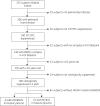Prevalence of M184V and K65R in proviral DNA from PBMCs in HIV-infected youths with lamivudine/emtricitabine exposure
- PMID: 33734374
- PMCID: PMC8212770
- DOI: 10.1093/jac/dkab080
Prevalence of M184V and K65R in proviral DNA from PBMCs in HIV-infected youths with lamivudine/emtricitabine exposure
Abstract
Objectives: We analysed the prevalence of M184V/I and/or K65R/E/N mutations archived in proviral DNA (pDNA) in youths with perinatal HIV, virological control and who previously carried these resistance mutations in historic plasma samples.
Methods: We included vertically HIV-infected youths/young adults aged ≥10 years in the Madrid Cohort of HIV-1 Infected Children and Adolescents, exposed to lamivudine and/or emtricitabine, with M184V/I and/or K65R/E/N in historic plasma samples, on antiretroviral therapy (ART), virologically suppressed (HIV-1 RNA <50 copies/mL), and with available PBMCs in the Spanish HIV BioBank. Genomic DNA was extracted from PBMCs and HIV-1 RT gene was amplified and sequenced for resistance testing by Stanford HIV Resistance tool.
Results: Among the 225 patients under follow-up in the study cohort, 13 (5.8%) met selection criteria, and RT sequences were recovered in 12 (92.3%) of them. All but one were Spaniards, carrying subtype B, with a median age at PBMCs sampling of 21.3 years (IQR: 15.6-23.1) with 4 years (IQR 2.1-6.5) of suppressed viral load (VL). Nine (75%) youths did not present M184V/I in pDNA after at least 1 year of viral suppression. In December 2019, the remaining three subjects carrying M184V/I in pDNA maintained suppressed viraemia, and two still used emtricitabine in ART.
Conclusions: The prevalence of resistance mutations to lamivudine and emtricitabine in pDNA in a cohort of youths perinatally infected with HIV who remain with undetectable VL, previously lamivudine and/or emtricitabine experienced, was infrequent. Our results indicate that ART including lamivudine or emtricitabine may also be safe and successful in youths with perinatal HIV with previous experience of and resistances to these drugs detected in plasma.
© The Author(s) 2021. Published by Oxford University Press on behalf of the British Society for Antimicrobial Chemotherapy.
Figures
References
-
- Charpentier C, Lambert-Niclot S, Visseaux B. et al. Evolution of the K65R, K103N and M184V/I reverse transcriptase mutations in HIV-1-infected patients experiencing virological failure between 2005 and 2010. J Antimicrob Chemother 2013; 68: 2197–8. - PubMed
-
- Rojas Sánchez P, de Mulder M, Fernandez-Cooke E. et al. Clinical and virologic follow-up in perinatally HIV-1-infected children and adolescents in Madrid with triple-class antiretroviral drug-resistant viruses. Clin Microbiol Infect 2015; 21: 605.e1–9. - PubMed
-
- Cahn P, Madero JS, Arribas JR. et al. Dolutegravir plus lamivudine versus dolutegravir plus tenofovir disoproxil fumarate and emtricitabine in antiretroviral-naive adults with HIV-1 infection (GEMINI-1 and GEMINI-2): week 48 results from two multicentre, double-blind, randomised, non-inferiority, phase 3 trials. Lancet 2019; 393: 143–55. - PubMed
-
- van Wyk J, Ajana F, Bisshop F. et al. Efficacy and safety of switching to dolutegravir/lamivudine fixed-dose 2-drug regimen vs continuing a tenofovir alafenamide-based 3- or 4-drug regimen for maintenance of virologic suppression in adults living with human immunodeficiency virus type 1: phase 3, randomized, noninferiority TANGO study. Clin Infect Dis 2020; 71: 1920–9. - PMC - PubMed
-
- de Miguel Buckley R, Montejano R, Stella-Ascariz N. et al. New strategies of ARV: the road to simplification. Curr HIV/AIDS Rep 2018; 15: 11–9. - PubMed
Publication types
MeSH terms
Substances
LinkOut - more resources
Full Text Sources
Other Literature Sources
Medical
Miscellaneous


